Page 179 of 330
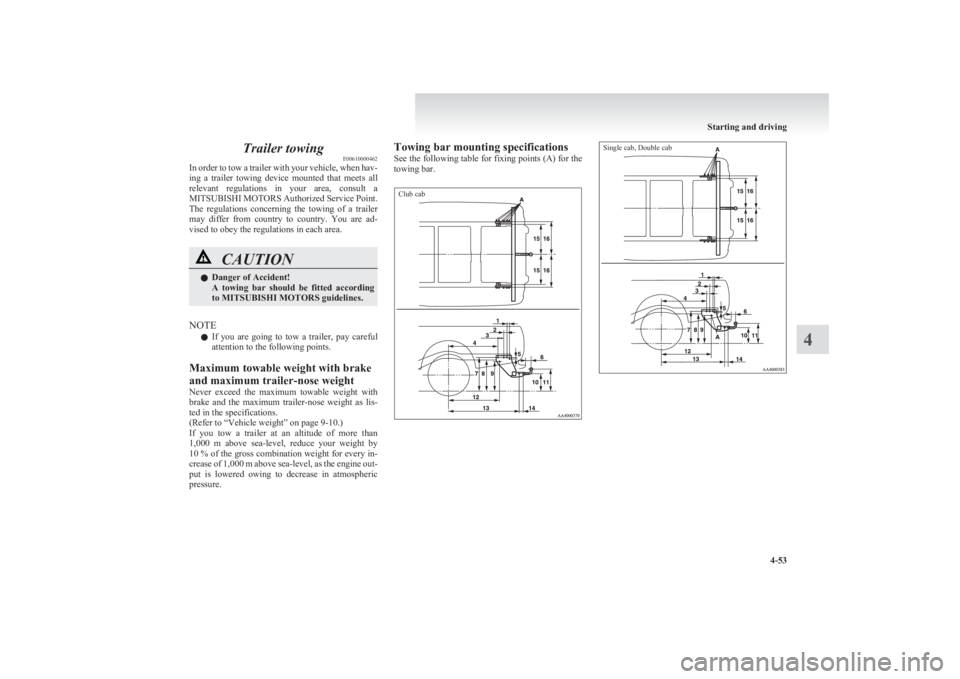
Trailer towingE00610000462
In order to tow a trailer with your vehicle, when hav-
ing a trailer towing device mounted that meets all
relevant regulations in your area, consult a
MITSUBISHI MOTORS Authorized Service Point.
The regulations concerning the towing of a trailer
may differ from country to country. You are ad-
vised to obey the regulations in each area.CAUTIONl Danger of Accident!
A towing bar should be fitted according
to MITSUBISHI MOTORS guidelines.
NOTE
l If you are going to tow a trailer, pay careful
attention to the following points.
Maximum towable weight with brake
and maximum trailer-nose weight
Never exceed the maximum towable weight with
brake and the maximum trailer-nose weight as lis-
ted in the specifications.
(Refer to “Vehicle weight” on page 9-10.)
If you tow a trailer at an altitude of more than
1,000 m above sea-level, reduce your weight by
10 % of the gross combination weight for every in-
crease of 1,000 m above sea-level, as the engine out-
put is lowered owing to decrease in atmospheric
pressure.
Towing bar mounting specifications
See the following table for fixing points (A) for the
towing bar.Club cabSingle cab, Double cab
Starting and driving
4-53
4
Page 180 of 330
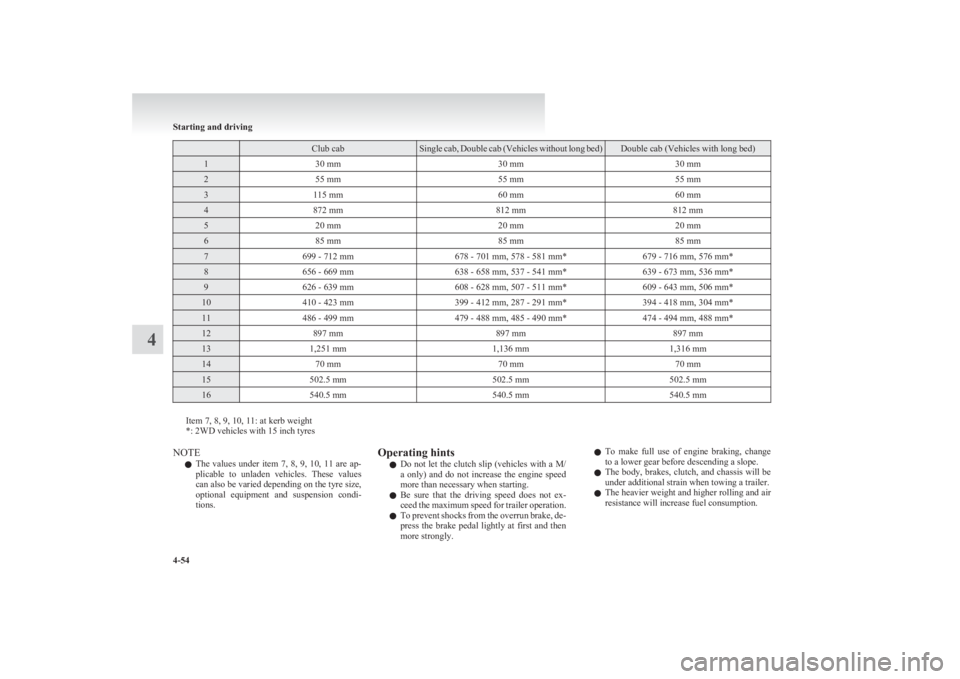
Club cabSingle cab, Double cab (Vehicles without long bed)Double cab (Vehicles with long bed)130 mm30 mm30 mm255 mm55 mm55 mm3115 mm60 mm60 mm4872 mm812 mm812 mm520 mm20 mm20 mm685 mm85 mm85 mm7699 - 712 mm678 - 701 mm, 578 - 581 mm*679 - 716 mm, 576 mm*8656 - 669 mm638 - 658 mm, 537 - 541 mm*639 - 673 mm, 536 mm*9626 - 639 mm608 - 628 mm, 507 - 511 mm*609 - 643 mm, 506 mm*10410 - 423 mm399 - 412 mm, 287 - 291 mm*394 - 418 mm, 304 mm*11486 - 499 mm479 - 488 mm, 485 - 490 mm*474 - 494 mm, 488 mm*12897 mm897 mm897 mm131,251 mm1,136 mm1,316 mm1470 mm70 mm70 mm15502.5 mm502.5 mm502.5 mm16540.5 mm540.5 mm540.5 mm
Item 7, 8, 9, 10, 11: at kerb weight
*: 2WD vehicles with 15 inch tyres
NOTE
l The values under item 7, 8, 9, 10, 11 are ap-
plicable to unladen vehicles. These values
can also be varied depending on the tyre size,
optional equipment and suspension condi-
tions.Operating hints
l Do not let the clutch slip (vehicles with a M/
a only) and do not increase the engine speed
more than necessary when starting.
l Be sure that the driving speed does not ex-
ceed the maximum speed for trailer operation.
l To prevent shocks from the overrun brake, de-
press the brake pedal lightly at first and then
more strongly.l To make full use of engine braking, change
to a lower gear before descending a slope.
l The body, brakes, clutch, and chassis will be
under additional strain when towing a trailer.
l The heavier weight and higher rolling and air
resistance will increase fuel consumption.
Starting and driving
4-54
4
Page 246 of 330

Spare wheelE00801100094
The spare wheel is stored under the floor of the car-
go bed.
A- Spare wheel
CAUTIONl When removing the spare wheel, put on
gloves. Removing the spare wheel with
your bare hands may cause injury to the
fingers.CAUTIONl Check the air pressure of the spare wheel
frequently and make sure it is ready for
emergency use at any time.
Driving with an insufficient tyre pressure
can lead to an accident. If you have no
choice but to drive with an insufficient
tyre pressure, keep your speed down and
inflate the tyre to the correct pressure as
soon as possible. (Refer to “Tyre inflation
pressures” on page 8-12.)
Maintaining the spare wheel at the high-
est specified air pressure will ensure that
it can always be used under any condi-
tions (city/high-speed driving, varying
load weight, etc.).
To remove
1.Set the jack handle. (Club cab, Double cab
with rear retractable power window only)
( Refer to “To use the jack handle” on page
6-12.)
2. Insert the jack handle (A) in the hole (B) be-
low the rear gate.
3. Securely insert the pin (C) on the jack handle
into the holder (D) of the spare wheel carrier.
4. Insert the wheel nut wrench (E) through the
end of the jack handle hole (F), and then turn
it anticlockwise to lower the spare wheel com-
pletely to the ground and to slack the chain.
For emergencies
6-16
6
Page 253 of 330
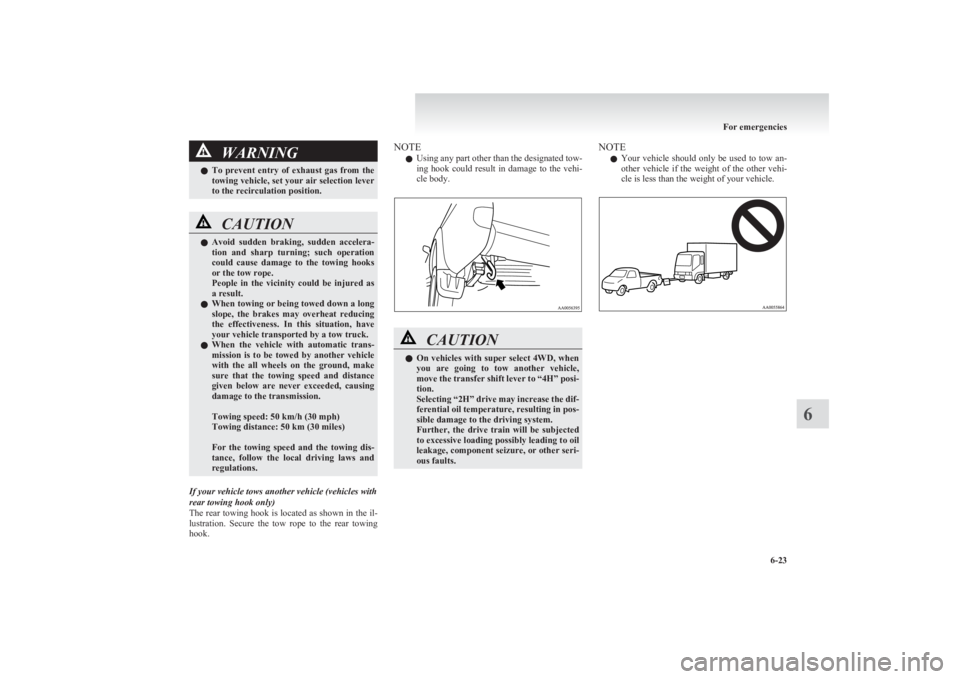
WARNINGlTo prevent entry of exhaust gas from the
towing vehicle, set your air selection lever
to the recirculation position.CAUTIONl Avoid sudden braking, sudden accelera-
tion and sharp turning; such operation
could cause damage to the towing hooks
or the tow rope.
People in the vicinity could be injured as
a result.
l When towing or being towed down a long
slope, the brakes may overheat reducing
the effectiveness. In this situation, have
your vehicle transported by a tow truck.
l When the vehicle with automatic trans-
mission is to be towed by another vehicle
with the all wheels on the ground, make
sure that the towing speed and distance
given below are never exceeded, causing
damage to the transmission.
Towing speed: 50 km/h (30 mph)
Towing distance: 50 km (30 miles)
For the towing speed and the towing dis-
tance, follow the local driving laws and
regulations.
If your vehicle tows another vehicle (vehicles with
rear towing hook only)
The rear towing hook is located as shown in the il-
lustration. Secure the tow rope to the rear towing
hook.
NOTE
l Using any part other than the designated tow-
ing hook could result in damage to the vehi-
cle body.CAUTIONl On vehicles with super select 4WD, when
you are going to tow another vehicle,
move the transfer shift lever to “4H” posi-
tion.
Selecting “2H” drive may increase the dif-
ferential oil temperature, resulting in pos-
sible damage to the driving system.
Further, the drive train will be subjected
to excessive loading possibly leading to oil
leakage, component seizure, or other seri-
ous faults.NOTE
l Your vehicle should only be used to tow an-
other vehicle if the weight of the other vehi-
cle is less than the weight of your vehicle.
For emergencies
6-23
6
Page 297 of 330
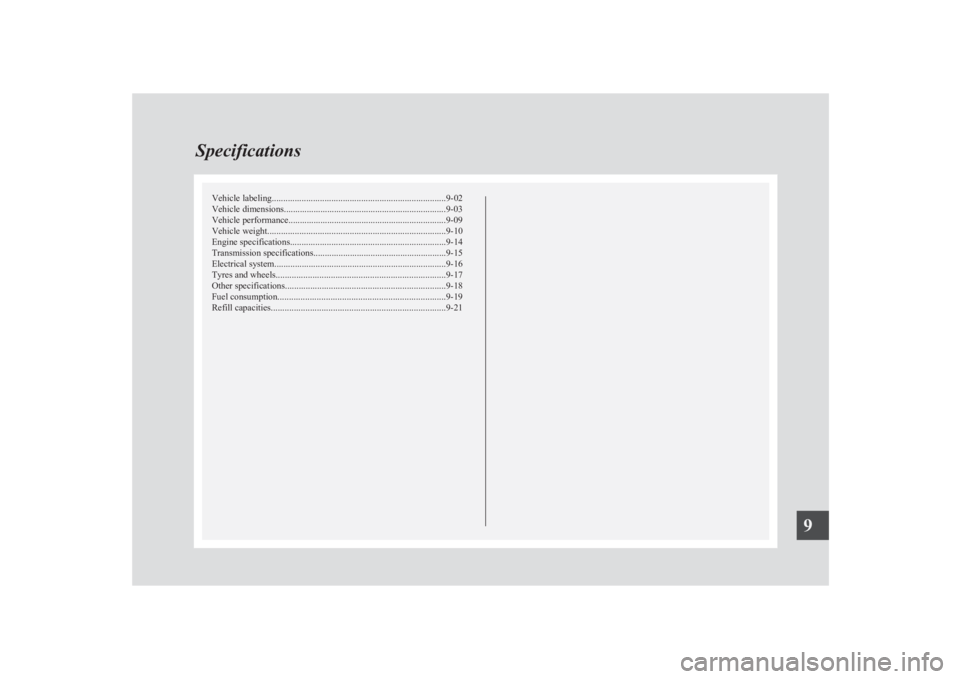
Vehicle labeling............................................................................ 9-02
Vehicle dimensions.......................................................................9-03
Vehicle performance.....................................................................9-09
Vehicle weight .............................................................................. 9-10
Engine specifications .................................................................... 9-14
Transmission specifications .......................................................... 9-15
Electrical system ........................................................................... 9-16
Tyres and wheels .......................................................................... 9-17
Other specifications ...................................................................... 9-18
Fuel consumption ......................................................................... 9-19
Refill capacities ............................................................................ 9-21Specifications9
Page 306 of 330
Vehicle weightE01100404160Single cabItem2WD4WDLHDRHDKerb weightWithout optional parts1,555 kg1,770 kgWith full optional parts1,585 kg1,830 kg1,810 kgMaximum gross vehicle weight2,630 kg2,850 kg2,890 kgMaximum axle weightFront1,030 kg1,260 kgRear1,700 kg1,800 kgMaximum towable weightWith brake1,800 kg2,700 kgWithout brake750 kgMaximum trailer-nose weight77 kg115 kgMaximum gross combination weight4,400 kg5,500 kg5,540 kgSeating capacity (including a driver)2 persons, 3 persons**
: Vehicles equipped with bench seat
NOTE
l Trailer specifications indicate the manufacturer’s recommendation.
l When loading luggage and/or towing a trailer, make sure not to exceed any of the above maximum weights all the time.
Club cabItemEasy select 4WDSuper select 4WDLHDRHDKerb weightWithout optional parts1,790 kg1,805 kg, 1,815 kg *With full optional parts1,890 kg1,870 kg1.900 kg, 1.910 kg **
: Vehicles with high power engine
Specifications
9-10
9
Page 307 of 330
ItemEasy select 4WDSuper select 4WDLHDRHDMaximum gross vehicle weight2,850 kgMaximum axle weightFront1,260 kgRear1,800 kgMaximum towable weightWith brake2,700 kgWithout brake750 kgMaximum trailer-nose weight115 kgMaximum gross combination weight5,500 kgSeating capacity (including a driver)4 persons*: Vehicles with high power engine
NOTE
l Trailer specifications indicate the manufacturer’s recommendation.
l When loading luggage and/or towing a trailer, make sure not to exceed any of the above maximum weights all the time.
Double cab
Item
2WDM/T
A/T
Vehicles with 15 inch
tyresVehicles with 16 inchtyresKerb weightWithout optional parts1,655 kg1,760 kg1,770 kgWith full optional parts1,725 kg1,890 kg1,900 kgMaximum gross vehicle weight2,630 kg2,800 kgMaximum axle weightFront1,030 kg1,260 kgRear1,700 kg1,800 kg
Specifications
9-11
9
Page 308 of 330
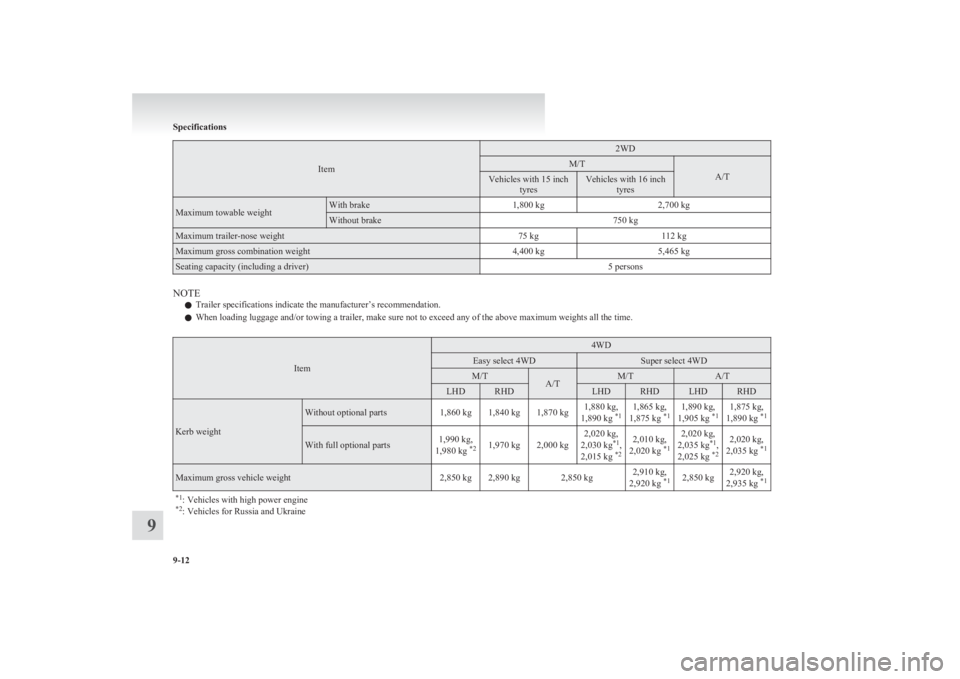
Item
2WDM/T
A/T
Vehicles with 15 inchtyresVehicles with 16 inchtyresMaximum towable weightWith brake1,800 kg2,700 kgWithout brake750 kgMaximum trailer-nose weight75 kg112 kgMaximum gross combination weight4,400 kg5,465 kgSeating capacity (including a driver)5 persons
NOTE
l Trailer specifications indicate the manufacturer’s recommendation.
l When loading luggage and/or towing a trailer, make sure not to exceed any of the above maximum weights all the time.
Item
4WDEasy select 4WDSuper select 4WDM/TA/TM/TA/TLHDRHDLHDRHDLHDRHD
Kerb weight
Without optional parts1,860 kg1,840 kg1,870 kg1,880 kg,
1,890 kg *11,865 kg,
1,875 kg *11,890 kg,
1,905 kg *11,875 kg,
1,890 kg *1With full optional parts1,990 kg,
1,980 kg *21,970 kg2,000 kg2,020 kg,
2,030 kg *1
,
2,015 kg *22,010 kg,
2,020 kg *12,020 kg,
2,035 kg *1
,
2,025 kg *22,020 kg,
2,035 kg *1Maximum gross vehicle weight2,850 kg2,890 kg2,850 kg2,910 kg,
2,920 kg *12,850 kg2,920 kg,
2,935 kg *1*1
: Vehicles with high power engine
*2 : Vehicles for Russia and Ukraine
Specifications
9-12
9